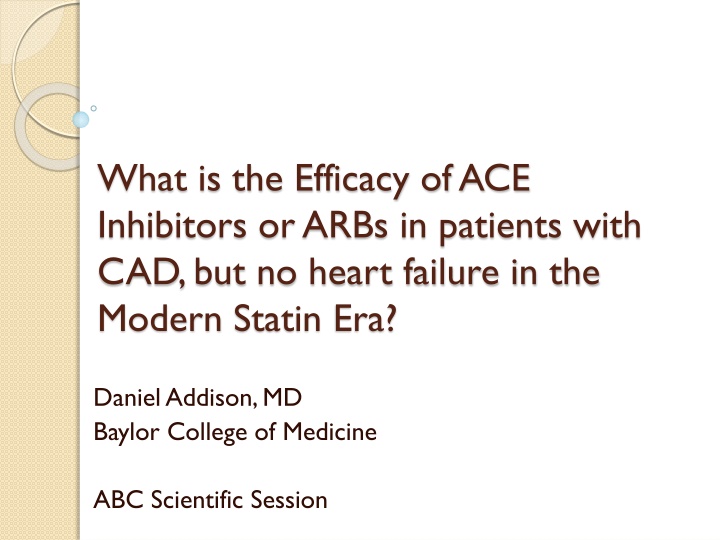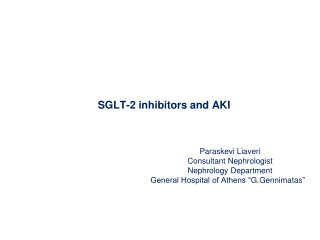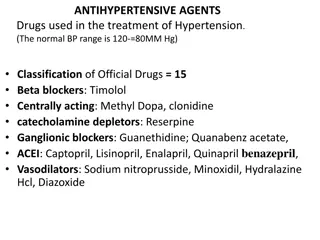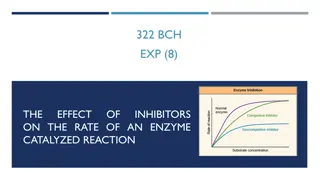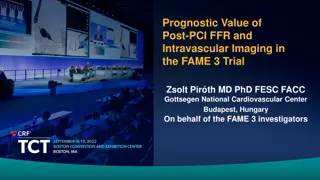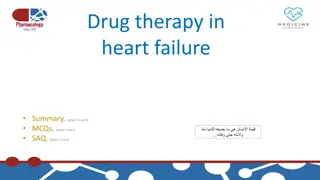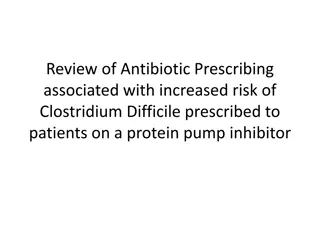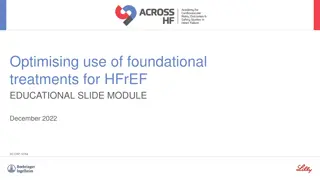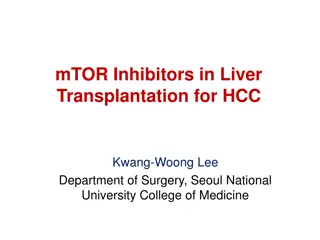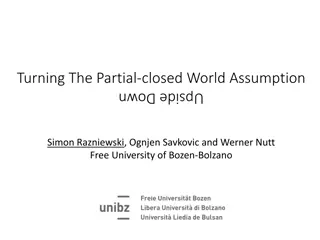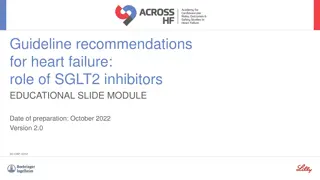Efficacy of ACE Inhibitors and ARBs in Patients with CAD
Coronary artery disease (CAD) is a significant health concern globally, leading to millions of deaths annually. The use of ACE inhibitors and ARBs in CAD patients without heart failure is a subject of debate, with modest benefits reported in some studies.
Download Presentation

Please find below an Image/Link to download the presentation.
The content on the website is provided AS IS for your information and personal use only. It may not be sold, licensed, or shared on other websites without obtaining consent from the author.If you encounter any issues during the download, it is possible that the publisher has removed the file from their server.
You are allowed to download the files provided on this website for personal or commercial use, subject to the condition that they are used lawfully. All files are the property of their respective owners.
The content on the website is provided AS IS for your information and personal use only. It may not be sold, licensed, or shared on other websites without obtaining consent from the author.
E N D
Presentation Transcript
What is the Efficacy of ACE Inhibitors or ARBs in patients with CAD, but no heart failure in the Modern Statin Era? Daniel Addison, MD Baylor College of Medicine ABC Scientific Session
Health Impact of Coronary Artery Disease Coronary artery disease (CAD) is the leading cause of death worldwide > 7 million deaths in 2010 up from 5.2 million in 1990 > 600,000 deaths in the U.S. (1 in 4 deaths) An estimated 16.8 million American adults have CAD this year, approximately 785,000 Americans suffer their first myocardial infarction (MI) another 470,000 suffer an additional MI In 2010, CAD alone cost the U.S. >$100 billion including the cost of health care services, medications, and lost productivity Mini o AM, et al. Natl Vital Stat Rep 2011;60(3); Lloyd-Jones D, et al. Circulation 2009;119:e21-181.
Current Standard Therapy for CAD Standard therapy that can reduce cardiovascular events: Single or dual anti-platelet therapy Statins -blockers Aggressive modification of risk factors Standard therapy that can help with symptoms: Fast-acting nitrates Negative chronotropic agents ( -blockers; nondihydropyridine CCBs) Vasodilators (CCBs; long-acting nitrates) CCB = calcium channel blockers Gibbons RJ, et al. J Am Coll Cardiol 2002;41:159-68; Fraker TD, Fihn SD. J Am Coll Cardiol 2007;50:2264-74.
Patients With Stable Ischemic Heart Disease, but no Heart Failure ACEIs and ARBs have established benefit in patients with heart failure and left ventricular (LV) dysfunction The evidence for prophylactic use of ACEIs and ARBs in CAD patients without heart failure and with preserved LV systolic function is less clear a majority of prior meta-analyses have pointed toward modest benefit Despite some controversy, ACC/ AHA practice guidelines support their use in this population with a Class II recommendation the same applies to those at high risk for CAD ACEI = angiotensin-converting enzyme inhibitor; ARB = angiotensin II-receptor blocker.
Are these agents beneficial in the more Contemporary era? Prior RCTs revealed variable results, with the majority revealing only modest benefit but most the data were derived from RCTs > 10 yrs ago was this benefit, driven by another confounder?? The benefits of ACEi and ARBs in this population are perceived to be driven by down-regulation of the atherothrombotic process Statins modulate a number of the same pathways We postulate that the variation in efficacy of ACEi and ARBs in preventing cardiovascular events in this population may be related to the rising use of Statins over the past two decades RCTs = randomized control trials.
Study Goals Examine whether routine use of either ACEi or ARBs in patients with or at high risk for CAD, without heart failure is beneficial in reducing cardiovascular events We also sought to address whether Statin use nullifies the need for these therapies At-risk = presence of any combination of the following: HTN, Diabetes, Dyslipidemia, or the presence of clinical atheromatous conditions (Cerebrovascular or Peripheral Vascular Disease)
Search Methods 1553 Potentially relevant publications indentified and screened (1980-2012) 1415 Publications excluded on basis of titles and abstracts 138 Publications retrieved for detailed review 111 Publications excluded on basis of exclusion criteria 29 Publications regarding patients with CAD and ACEi or ARB 3 Editorials 5 Sub-studies of an eligible study 2 No extractable data 19 Randomized-controlled trials with ACEi or ARB as single intervention MEDLINE search terms (1/1/1980 - 12/31/2012): angiotensin-converting enzyme inhibitors, angiotensin receptor blockers, coronary artery disease, cardiovascular events, and myocardial infarction
Summary of Trials Investigating the Addition of an ACEI or ARB to Standard Medical Therapy (SMT) for Ischemic Heart Disease without Heart Failure Clinical Trial & Yr Group Drug N Follow-up (Months) SAVE (1992) ACEI Captopril 2,231 42 SMILE (1995) ACEI Zofenopril 1,556 1.5 CAPPP (1999) ACEI Captopril 10,985 60 APRES (2000) ACEI Ramipril 159 33 HOPE (2000) ACEI Ramipril 9,297 60 PART-2 (2000) ACEI Ramipril 617 48 PROGRESS (2001) ACEI Perindopril 6,105 47 QUIET (2001) ACEI Quinapril 1,750 27 EUROPA (2003) ACEI Perindopril 12,218 50 PEACE (2004) ACEI Trandolapril 8,290 58 CAMELOT (2004) ACEI Enalapril 1,991 24 DREAM (2006) ACEI Ramipril 5,269 36 PREAMI (2006) ACEI Perinodopril 1,252 12 SMILE-ISCHEMIA (2007) ACEI Zofenopril 349 6 IDNT (2001) ARB Irbesartan 1,148 31 RENAAL (2001) ARB Lorsartan 1,513 41 TRANSCEND (2008) ARB Telmisartan 5,926 56 PROFESS (2008) ARB Telmisartan 20,332 30 NAVIGATOR (2010) ARB Valsartan 9,306 60
Results: All-Cause Mortality (ACEi or ARB added to SMT)
Results: Cardiovascular Mortality (ACEi or ARB added to SMT)
Results: Non-fatal MI (ACEi or ARB added to SMT)
Results: Stroke (ACEi or ARB added to SMT)
Results: Combined Endpoints (ACEi or ARB added to SMT)
Summary of the Results of Addition of an ACEI or ARB to SMT for Ischemic Heart Disease Without Heart Failure ACEI ARB Overall Outcome Risk Risk Risk Total Mortality Decreased (14%) No effect Decreased (8%) CV Mortality Decreased (18%) No effect Decreased (15%) Nonfatal MI No effect No effect No effect Stroke No effect Decreased (7%) No effect Combined Endpoint: Risk of Mortality, Nonfatal MI, and Stroke Decreased (16%) Decreased (9%) Decreased (14%) CV = cardiovascular; HF = heart failure; MI = myocardial infarction.
Summary of Meta-regression Results- Influence of Statins on Outcomes Metric: Odds Ratio Outcome Coefficients 95% CI Std. error p-Value -0.002 to 0.007 0.002 0.303 Total Mortality 0.003 0.001 to 0.010 0.002 0.034 CV Mortality 0.006 -0.004 to 0.006 0.004 0.193 Nonfatal MI 0.001 -0.005 to 0.011 0.004 0.307 Stroke 0.003 Combined Endpoint: Risk of Mortality, Nonfatal MI, and Stroke -0.005 to 0.005 0.003 0.579 0.000
Random Effects Model accounting for Statins: Cardiovascular Mortality Meta-regression: depicting of the relationship between the log-adjusted odds ratios (intervention of ACEi or ARB compared to Control arm) for the endpoint of Cardiovascular Death with the Percentage (%) of Statin use (%) Odds Ratio Coefficient: 0.006, p-value 0.034
Assessment of the Effects of Statins in CAD Patients, without Heart Failure on ACEi or ARB When regressed (adjusted) for Statin use there was a linear decrease in the odds of CV mortality reduction with ACEi or ARBs Odds Ratio coefficient = 0.006; p = 0.034 There were no other significant relationships between all-cause mortality, non-fatal MI, or stroke
Conclusions ACEi/ ARB are independently associated with decreased mortality in all ischemic heart disease patients But when accounting for Statin use in those without heart failure, the additive effects of ACEi/ ARBs in reducing CV mortality appear to be nullified The reasons for these results are not clear, and further investigation is warranted
Limitations Varying ACEi and ARBs were employed across the studies Varying Statins were utilized We were unable to account for differences in doses of both ACE/ ARBs as well as Statins We were able to account for variation in the amount of blood pressure reduction only mild/ minimal across all studies The study employed patients of varying CAD chronicity
Acknowledgements Co-authors- Vu Hoang, Yochai Birnbaum, Fransico Macedo, Salim Virani, Mahboob Alam
Extra Slides: Results of Trials Evaluating the Addition of an ACEI or ARB to SMT for Ischemic Heart Disease without Heart Failure Adding an ACEI or an ARB does provide additional clinical benefits reduced All-cause death reduced Cardiovascular death trend toward reduction in MI trend toward reduction in CVA Although less robust, benefit appears to be extended to the at-risk
Extra Slides: Trial Characteristics Trial Treatment Group Drug SAVE ACEI given 3 days after MI Captopril SMILE ACEI given > 24 hours after acute MI Zofenopril CAPPP ACEI given to the at-risk Captopril APRES ACEI given 5 - 7 days after CABG or 1 - 2 days after PTCA Ramipril HOPE ACEI given to stable CAD or at-risk patients Ramipril PART-2 ACEI given in stable CAD or at-risk patients to slow carotid atherosclerosis Ramipril QUIET ACEI given in stable CAD Quinapril EUROPA ACEI given in stable CAD Perindopril PEACE ACEI given in stable CAD Trandolapril CAMELOT Placebo v. ACEI or Amlodipine given to patients with stable CAD Enalapril ACEI given to patients with Impaired Glucose tolerance (nearly all with some other risk factor) to monitor to the development of DM DREAM Ramipril PREAMI ACEI given < 3 weeks after acute MI Perindopril SMILE- ISCHEMIA ACEI given post-MI Zofenopril IDNT ARB given to patients with HTN and DM to prevent nephropathy Irbesartan ARB given to patients with HTN and DM to monitor to the development of nephropathy RENAAL Lorsartan TRANSCEND ARB given to stable CAD or at-risk patients Telmisartan
Extra Slides: Reluctant Acceptance?? However debate still remains regarding the true utility of these agents in these CAD settings This is evidenced by the marked variation in the utilization of these agents in this population Duke Databank for Cardiovascular Disease for the year 2002 revealed that only 39% of patients with CAD and no heart failure were on ACEi therapy36 Only 26% of patients reported consistent use National Cardiovascular Data Registry Cath-PCI Registry published in 2010 revealed that only 59% of all obstructive CAD patients undergoing catheterization were placed on an ACEi at discharge37 Compared to 91% compliance with Asprin in the same population 2009 data from a large Vascular Disease Center in Ireland revealed only 65% compliance with ACEi therapy
Extra Slides: Why are clinicians under prescribing these drugs? The simple answer may be a lack of awareness of published data But this was added to the 2002 ACC/ AHA CAD guidelines Some have expressed hesitancy over the lack of heterogeneity in the available data examing this question Is there a confounding factor responsible for the lack of positive findings in some the major trials? Concern has also been raised regarding the blanket extension of the Class II recommendation given to ARBs Due to a less vigorous body of supporting evidence (ACC/ AHA level of B) Finally, polypharamacy has been proposed as a reason for the lack of physician prescriptions As well as patient continuation of these drugs
Extra Slides: Another Confounder? But the question of the question of the presence of a confounder raises both an important and enticing question Is there another agent influencing outcomes and the ability to show measurable major outcomes differences? The benefits of ACEi and ARBs in this population are thought to be driven by downregulation of the atherothrombotic process: endothelial dysfunction vascular inflammation progression of atherosclerosis vascular thrombotic tendency improved plaque stability Interestingly, Statins are thought to overlap in the modulation of a number of these same processes RCTs = randomized control trials.
